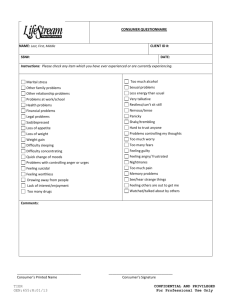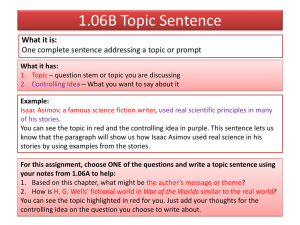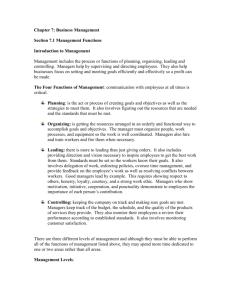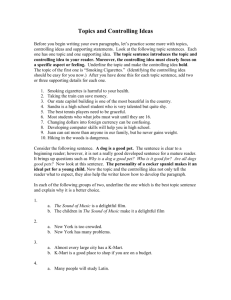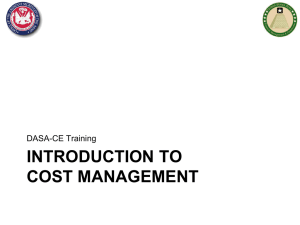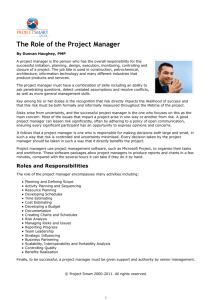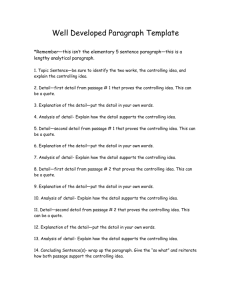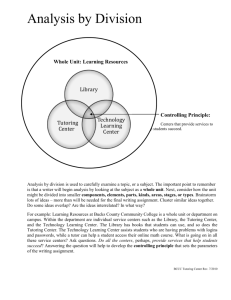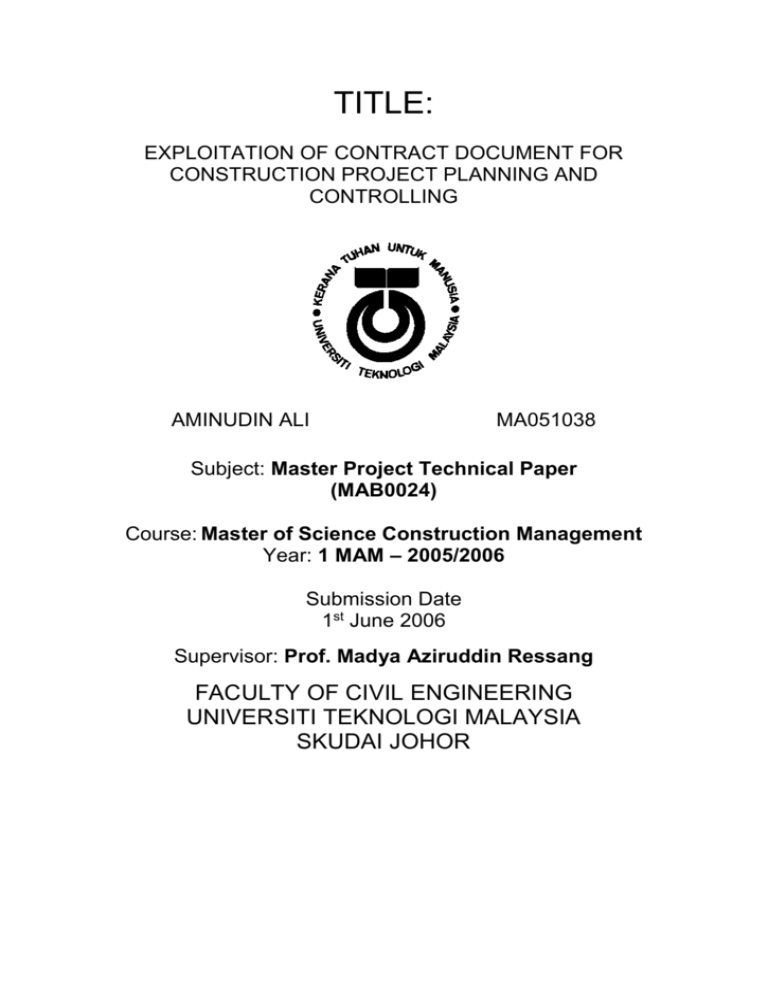
TITLE:
EXPLOITATION OF CONTRACT DOCUMENT FOR
CONSTRUCTION PROJECT PLANNING AND
CONTROLLING
AMINUDIN ALI
MA051038
Subject: Master Project Technical Paper
(MAB0024)
Course: Master of Science Construction Management
Year: 1 MAM – 2005/2006
Submission Date
1st June 2006
Supervisor: Prof. Madya Aziruddin Ressang
FACULTY OF CIVIL ENGINEERING
UNIVERSITI TEKNOLOGI MALAYSIA
SKUDAI JOHOR
i
TABLE OF CONTENT
page
1
ABSTRACT ................................................................................................................................. 1
1.1
INTRODUCTION ..................................................................................................................... 1
1.2
BACKGROUND OF THE PROBLEM ......................................................................................... 2
1.3
OBJECTIVE OF THE STUDY ................................................................................................... 3
1.4
THEORETICAL FRAMEWORK ............................................................................................... 3
1.5
STATEMENT OF HYPOTHESIS ............................................................................................... 4
1.5.1
Hypothesis statement 1 ................................................................................................. 4
1.5.2
Hypothesis statement 2 ................................................................................................. 4
1.5.3
Hypothesis statement 3 ................................................................................................. 4
1.6
RESEARCH QUESTION........................................................................................................... 4
1.6.1
The Important of Construction Planning and Controlling Function Research
Questions....................................................................................................................................... 4
1.6.2
The Usage of Contract Document for Construction planning and controlling
Research Questions ...................................................................................................................... 4
1.6.3
The Exploitation of Contract Document for Construction planning and controlling
Research Questions ...................................................................................................................... 5
1.7
SCOPE OF STUDY ................................................................................................................... 5
1.8
RESEARCH METHODOLOGY ................................................................................................. 5
1.8.1
Methodology Phase 1 .................................................................................................... 5
1.8.2
Methodology Phase 2 .................................................................................................... 5
1.8.3
Methodology Phase 3 .................................................................................................... 6
1.9
RESEARCH METHODOLOGY CHART .................................................................................... 6
1.10 RESEARCH ANALYSIS AND FINDINGS ................................................................................... 7
1.10.1 Document Study ............................................................................................................ 7
1.10.2
Document Study Findings ............................................................................................ 7
1.10.3
Questionnaire Survey ................................................................................................... 7
1.10.4
Questionnaire Survey Findings .................................................................................... 7
1.10.5
Structured and Telephone Interviews ........................................................................ 10
1.10.6
Structured and Telephone Interviews Findings ........................................................ 10
1.10.7
Proposed Exploitation Model ..................................................................................... 12
1.10.8
Proposed Exploitation Model Findings ..................................................................... 12
1.11 DISCUSSION AND CONCLUSION .......................................................................................... 12
1.12 OBJECTIVE 1: TO IDENTIFY THE CONSTRUCTION PLANNING AND CONTROLLING
FUNCTIONS WITHIN THE CONTENT OF THE CONTRACT DOCUMENT ........................................... 12
1.13 OBJECTIVE 2: TO IDENTIFY THE USAGE OF CONTRACT DOCUMENT FOR CONSTRUCTION
PROJECT PLANNING AND CONTROLLING FUNCTIONS................................................................... 12
1.14 OBJECTIVE 3: TO PROPOSE EXPLOITATION TO CONTRACT DOCUMENT FOR
CONSTRUCTION PROJECT PLANNING AND CONTROLLING FUNCTIONS ....................................... 13
1.15 RECOMMENDATION ............................................................................................................ 13
2
REFERENCES AND BIBLIOGRAPHY ................................................................................ 14
2.1
2.2
REFERENCES .................................................................................................................. 14
BIBLOGRAPHY ............................................................................................................... 15
3
APPENDIX 1: UTM CONSTRUCTION PROJECT 7TH MALAYSIANS’ PLAN 1995 TO
2000 ..................................................................................................................................................... 16
Master Project MAB0024/Aminudin Ali/PM Aziruddin/June06
1
EXPLOITATION OF CONTRACT DOCUMENT FOR CONSTRUCTION PROJECT PLANNING AND
CONTROLLING
Supervisor: Profesor Madya Aziruddin Ressang
__________________________________________________________________________________________
1
Abstract
Construction industry was plague with multitude of criticism and tribulations in the perspective of the client for
cost overruns and delays. The broad-spectrum regions of problems were within the planning and controlling
functions. Proper contract documentation between contracting parties within the planning and controlling
functions are able to reduce the predicament. A Document Study was done for 16 numbers of construction
contract document in UTM during the period of the 7th Malaysians’ Plan from 1995 to 2000 with the total value
of all projects in the excess RM70 million. The Client, Consultant, and Contractor become the main respondent
target. The process of review, analyze and synthesis of contract documents reveal 485 verses and phrase related
to project planning and controlling functions that is further synthesis into 209 keywords. Time functions were
establish to be the most important factor of planning and controlling within the contract document followed by
cost function. The usage of contract document to identify construction activity function scored the highest within
the content of Construction Drawing and secondly, the construction cost function within the content of Bills of
Quantities. The respondent rated the highest score for the contract document to be very important for
construction planning and controlling. In general, the contract document is also appraised as highly used for
construction planning and controlling function. Proposals were made to introduce new Bills of Activities in the
contract document using a selected project for the exploitation validation. Microsoft Project 2003 was employed
to simulate and verify the proposal. Finally, for the exploitation of the contract document, 93% of the
respondent agreed that the contract document can be modified to become a Master Plan for the construction
planning and control function to be contracted in the contract document, legally and binding.
Keywords: Construction planning, Construction controlling and Contract document
__________________________________________________________________________________________
1.1
Introduction
The intricate nature of construction industry aggravated by its’ reactive and capricious characteristic are
generally due to its fundamental business core based on one-off projects and temporary relationships. It is to be
expected that it carries with it a multitude of criticism and tribulations in the perspective of the client for a
construction project (Knight et al 2002). The fragmentation of the industry is exacerbated by the insularity of the
professions in project planning and controlling; the contract that separate design from construction; the
uniqueness of projects and the ephemeral nature of the relationships and project organization (Masterman,
2002).
By that, the progressively more complicated construction projects ensuing in complex contract documents.
Intricate contract and construction projects, not properly planned and controlled can often engulf in multifaceted
legal disputes that arise from the convolution and enormity of the work requiring multiple prime contracting
parties, inadequately organized and executed contract documents, insufficient planning and controlling,
financial matters, and communication difficulty (Harmon, 2003). All of these factors or any one of them can
ruin a project and lead to complicated litigation or arbitration, increased costs, and delay thus breaking down in
the parties' communication and relationship form the initial intention of contract.
The contracting parties in a construction project are the owner, the consultants, contractor and subcontractors,
are in circumstance with an intricate set of interrelated and intertwine relationships requiring cooperation and
collaboration to coordinate time, resources, and communication; that is the planning and control function
(Latham, 1994). The focal objective of the parties involved in a construction project is a victorious project. This
is translated as a project that has been constructed in accordance with the plans and specifications, within the
time and cost originally anticipated. The success of a project depends on a number of variables, not the least of
which is how the organizations approach conflicts relating to contract documentation, planning and control of
the project (Egan 1998).
Construction planning and controlling is a basic elementary and imperative action in the management and
implementation of construction projects. An excellent construction plan is the root for developing the budget
and the schedule for work. It involves the choice of technology, the definition of work tasks, the estimation of
the required resources and durations for individual tasks, and the identification of any interactions among the
parties of different work tasks (Patrick, 2004). The controlling functions on the other hand ensure the
performance achieved and satisfied as indicated in the planning process. Monitoring and controlling function
guaranteed that the construction project within budget, on time and as the quality specified furnished by a firstclass plan. In addition to these technical aspects of construction planning, it may also be necessary to make
organizational decisions about the relationships between project participants and even which organizations to
include in a project. At a construction site, various trades typically work separately on tasks specified in and
coordinated by the master schedule. But this doesn’t give them any incentive to work together, nor does it
provide for much planning on the best way to deliver a feature. These include the functions of contract
Master Project MAB0024/Aminudin Ali/PM Aziruddin/June06
2
documentation between each party that should bind together the contract with construction planning and
controlling function. Integration of contract documentation with planning and controlling at design development
in tandem provides a powerful tool in both the designers and the construction parties better understanding the
project constraints and opportunities (Hinze, 2004).
When the exploitation of contract document for construction project planning and controlling implemented and
the integration occurs, an even more powerful force is brought to bear on facilitating the project team to obtain a
fuller understanding of the project plan. If this is undertaken under an integrated design and construction
procurement choice then the whole project teams have a far better opportunity to understand the project more
fully and hence plan the construction work more effectively (Smith, et al 2003). The potential outcomes are
better planning; safer construction, less waste, lower detrimental environmental impact, better quality, and a
more practical and elegant design solution. These outcomes can be reasonably assumed to facilitate outcomes of
lower cost and improved construction time performance. Waste and rework has been argued to considerably
contribute to higher construction cost and time (Li et al., 2000; Love et al., 2000).
1.2
Background of the Problem
Numeral prominent reports published in the 1990s that have identified the dilemma of the construction industry.
The Latham (1994) and Egan Reports (1998) from the UK and in Australia the recent Australian Construction
Industry Action Agenda, Building for Growth (DISR, 1999) addressed problems in the construction industry
and areas where reform is required. Common threads of these reports are issues relating to the inefficiencies of
traditional approach. This is evidence for the need to improve the procurement methods through the integration
of contract and construction process to increase the value for the end user (Comptroller and Auditor General
2001). Table 1 combines the key performance indicators and recommendations of the Egan Report (1998) with
parallel key initiatives identified in Building for Growth (DISR, 1999).
The third key driver has been identified as Integrated process and teams, among others the resolution were in
the contracting parties in becoming team work driven by the integration between the contract documentation
with the planning and control system. The Malaysian issue has not been further apart from the Australian and
UK panorama, even though there is no specific report on construction development issues in Malaysia, but
following the newspaper reviews the sickness were similar.
Table 1-1 Key Drivers for Change in the Construction industry
Source: Smith, et al 2003
Malaysian’s construction industry predicament currently revolves on the issue of defect in a major infrastructure
work, where cracks appears at the column of the MRR2 fly over bridge in Kuala Lumpur (Strait Times, Jan
2006). The contracts between the parties involved do not clearly identify their roles in the Design and built
contract resulting in poor construction and management (Berita, Feb 2006). The delay of Durin Bridge a mega
project in Sarawak resulting in 6 numbers of extensions of times amounting to 34 months was awarded to the
construction consortium. The enormous amount of time including contract termination and re-award of contract
to a new contractor, is a clear indication of mismanagement of poor planning and controlling of whatever the
other reason given for the delay and contract problems (Berita, Feb 2006).
Further down the history of construction industry since 1980’s the government was concern with the project
management in particular of planning and controlling of construction project (Utusan, May 1982). This was
further discussed and elaborated by Nation Central Production Force (Pusat Daya Pengeluaran Negara) in
various articles to promote a better understanding of the contractor in project planning and control (Utusan,
October 1984, Utusan August 1985, Berita November 1985, Utusan February 1986, Utusan August 1986).
Late 1980’s and early 1990 shows the emergence of the new procurement system and the era of transfer of
technology that integrate local and foreign contractor in the construction of Daya Bumi, LUTH Building, PNB
Master Project MAB0024/Aminudin Ali/PM Aziruddin/June06
3
building, Menara May Bank and others (Strait Times, April 1987, Strait Times, January 1990, Utusan March
1990). This is further lead into the introduction of Design and Built project, Package Deal, Turn Key, Project
Management Consultant and others for local project for the local contractor. With this new procurement system
and contractual documentation, high hope vested upon the industry to increase the performance of the
construction project. Few projects were successful for example the construction of government clinic by the
Ministry of Health through the 7th Malaysians’ Plan from 1995 to 2000 (Lim, 2000).
In contrast, most of the construction projects are often plagued with delays and cost overruns, revealing this
shows that most of the construction of Government School Projects initiated by Ministry of Educations
especially for the School Computer Laboratory Projects, were 100% delays and Housing Quarters for Teachers
only 412 units completed out of 1900 units targeted in the 7th Malaysians’ Plan from 1995 to 2000. (Utusan,
January 2002, Berita, March 2002, Utusan, September 2002).
The contractual liabilities of the new procurement system did provide control with no emphasis on planning
process bring about the government decision not to use the new procurement system and reverted to the relevant
agencies such as Public Work Department (PWD) and ministries to oversee new projects with the normal
traditional method (Ismail, 2005).
Envisage the more secure ground for construction contracting, following the above mention government
decision, University Teknologi Malaysia (UTM) has been using some Design and Built and Project
Management System in their project delivery system. Most of the construction projects were contract out using
traditional method, which is Contract Document with or without bills of quantities. Most of the projects were
delayed with certain amount of variation order increasing the original value of the contract sum. The significant
of the study would be on the total value of all projects in the excess RM60 million with less then 20 numbers of
projects reviewed during the period of the 7th Malaysians’ Plan from 1995 to 2000.
With the general background of the problems in the construction industry and the specific problems within the
UTM construction scope, the writer are insinuating the idea of exploitation of the contract document for
construction planning and controlling for the future benefit of UTM upcoming construction project.
1.3
Objective of the Study
The purposes of the study are systematically divided in 3 stages in consecutive sequence.
1.
2.
3.
To identify the construction planning and controlling functions within the content of the Contract
Document
To identify the usage of the Contract Document for construction project planning and controlling
functions
To proposed exploitation to the Contract Document for construction project planning and controlling
functions
1.4
Theoretical Framework
The Primary Theoretical Framework that overview the general study of the research are The Latham (1994) and
Egan Reports(1998) from the UK and Australian Construction Industry Action Agenda, Building for Growth
(DISR, 1999) that categorize problems in the construction industry and areas where improvement is essential.
The key drivers identified from Table 1-1 are:
Committed Leadership
Focus on Customer
Integrated process and teams
Quality driven agenda
Commitment to people
Narrowing down to the Construction Contract Document Conceptual Theoretical Framework where UTM were
using JKR Standard Form of Contract according to Clause 1(a) of the JKR Form 203A (Rev 10/83) defines the
term contract document to mean, the document forming the tender and acceptance which include:
Article of Agreements;
Form of Tender;
Letter of Acceptance of Tender;
Condition of Contract and the appendix annexed thereto;
Contract Drawings;
Bills of Quantities;
Specifications ; and
Treasury Instructions are set out in the appendix to the condition of the contract.
Master Project MAB0024/Aminudin Ali/PM Aziruddin/June06
4
Finally, the 2nd Conceptual Theoretical Frameworks above are the constructions planning and control functions.
Both functions can be elaborated as follows:
Construction works or activities
Construction Cost
Construction quality
Construction Time
Construction Resources
The UK and Australian reports are regarded to be The Primary Theoretical Framework of the 3 main reports
encompassing 2 Conceptual Theoretical Framework that is the contract document and the planning and
controlling function. In this study, the core theory is the merging and integrating both of the Conceptual
Theoretical Framework with the process of exploitation shown in figure below.
THEORETICAL FRAMEWORK
PRIMARY AND CONCEPTUAL
THE PRIMARY THEORY
The Latham, Egan and DISR
CONCEPTUAL
CONCEPTUAL
THEORY
THEORY
Construction Exploitation Planning and
Contract
Controlling
Document
Function
Figure 1-1 Theoretical Framework: Primary and Conceptual Theory
1.5
Statement of Hypothesis
Hypothesis statement for this research are the summary of the functional assessment that include the description
of an educated guess of any suspected cause(s) of a process, procedure, or service that may exhibit problems,
defects, or errors.
1.5.1
Hypothesis statement 1
The content of the Contract Document are very important to construction planning and controlling
1.5.2
Hypothesis statement 2
The usage of the Contract Document are very highly used for construction project planning and
controlling
1.5.3
Hypothesis statement 3
No exploitation were made to the Contract document for the purpose of construction project planning
and controlling
1.6
Research Question
The proposed research question represents the central theme of research project and it is every aspect of the
project coordinated in an effort to identify a substantive answer to the question posed by the researcher at the
beginning of this process.
1.6.1
The Important of Construction Planning and Controlling Function Research Questions
How important the Contract Document for construction planning and control?
How important the information in Contract Document for construction planning and control?
1.6.2
The Usage of Contract Document for Construction planning and controlling Research Questions
What is the rating scale for the general usage of Contract Document for construction planning and control?
What is the rating scale for the usage of information in Contract Document for construction planning and
control?
Master Project MAB0024/Aminudin Ali/PM Aziruddin/June06
5
1.6.3
The Exploitation of Contract Document for Construction planning and controlling Research
Questions
Can Contract Document become a master plan for construction planning and controlling?
Can Contract Document be modified to become a master plan for construction planning and controlling?
Can construction planning and controlling function be contracted in the Contract Document?
1.7
Scope of Study
The important of the study scope would be reflected on the total value of all projects in the excess RM70 million
with 16 numbers of projects reviewed during the period of the 7th Malaysians’ Plan from 1995 to 2000, where
most of the UTM construction projects were implemented during this period. The listings of the projects are as
shown in Appendix 1.
The Primary Scopes of Study is the client organization (Harta Bina) and the Secondary Scopes of Study are
the contractors and consultants.
1.8
Research Methodology
The traditional academic research methodology combines a retrospective summary and contextualization of the
conceptualized research theoretical framework, the research question, and the hypothesis, within a proposed
research methodology framework (Cryer, 1996). 3 research methodology phases are developed to elaborate the
modus operandi answering the research objective as shown below.
1.8.1
Methodology Phase 1
RESEARCH METHODOLOGY
PHASE 1
Methodology Phase 1
Document Study
16 Documents
RM60Million
REVIEW
ANALYSIS
SYNTHESIS
OBJECTIVE 1
Contract Document Content for
Planning & Controlling Function
7th M’sian Plan
1995 – 2000
Digital Photo Study
Figure 1-2 Research Methodology Phase 1
1.8.2
Methodology Phase 2
RESEARCH METHODOLOGY
PHASE 2
Methodology Phase 2
STRUCTURED
INTERVIEW
QUESTIONNAIR
(5 scale Likert)
TELEPHONE
SURVEY
Figure 1-3 Research Methodology Phase 2
Master Project MAB0024/Aminudin Ali/PM Aziruddin/June06
Primary
Respondent
Pengarah Kerja
(Client)
OBJECTIVE 2
Usage of Contract Document for
Planning & Controlling Function
Secondary
Respondent
Contractor
Consultant
6
1.8.3
RESEARCH METHODOLOGY
Methodology Phase 3
PHASE 3
Methodology Phase 3
Primary
Respondent
Pengarah Kerja
(Client)
STRUCTURED
INTERVIEW
ANALYSIS
OBJECTIVE 3
QUESTIONNAIR
(5 scale Likert)
SYNTHESIS
Contract Document
Exploitation for Planning &
Controlling
TELEPHONE
SURVEY
PROPOSED
EXPLOITATION
Secondary
Respondent
Contractor
Consultant
Figure 1-4 Research Methodology Phase 3
1.9
Research Methodology Chart
Research methodology chart shows the overall the 3 phase of the research methodology in combination.
LITERATUR REVIEW
ENVELOPE
HUMAN
MEDIA
HARD COPY
MEDIA
ELECTRONIC
MEDIA
PROBLEM
STATEMENT
RESEARCH
OBJECTIVES
THEORETICAL
FRAMEWORK
RESEARCH
QUESTION
HYPOTHESIS
STATEMENT
REWIEV
RESEARCH DESIGN ENVELOPE
OBJECTIVE 1
Contract Document
Content for Planning &
Controlling Function
ANALYSIS
SYNTHESIS
Methodology
Phase 2
STRUCTURED
INTERVIEW
QUESTIONNAIR
TELEPHONE
SURVEY
STRUCTURED
JURUTERA AWAM
INTERVIEW
IKRAM
OBJECTIVE 2
Usage of Contract
Document for Planning
& Controlling Function
QUESTIONNAIR
TELEPHONE
SURVEY
OBJECTIVE 3
Contract Document
Exploitation for
Planning & Controlling
Function
RESEARCH ANALYSIS
& FINDINGS
CONCLUSION &
RECOMMENDATION
Figure 1-5 Overall Research Methodology Chart
Master Project MAB0024/Aminudin Ali/PM Aziruddin/June06
Methodology
Phase 1
Methodology
Phase 3
RESEARCH ANALYSIS &
FINDINGS ENVELOPE
7
1.10
Research Analysis and Findings
The research analysis is base on the primary research that include, 1) Document Study, 2) Questionnaire
Surveys, 3) Structured Interviews, 4) Telephone Interviews, and a 5) Proposed Exploitation Model that
apply both primary and secondary sources to integrate them in a cohesive approach within the primary and
conceptual theoretical framework.
1.10.1 Document Study
The object of a document study is to learn from a primary source of the principal task of historical study to
recover and interpret the physical remains of the past. It is a Qualitative Analysis process that precursor to
quantitative, statistical work; a process to make the tacit underpinnings of an issue explicit; a process to deepen
the understanding of verses and phrase that cannot be understood with numbers; a process that figure out what
to count and what to measure (Burke, 1998).
There are 16 numbers documents study of UTM construction Contract Document between the periods from
1995 to 2000 of the 7th Malaysians’ Plan with a total cost in the excess RM70 million as shown in Appendix 1.
The objects of the document study are to identify the planning and control function within its content.
Procedure of Document Study:
Step 1: Review
Strategic grouping, similarity of content and digital photograph study (due to control and limited document)
Step 2: Analysis
Construed and interpreted verses and phrase to identify the planning and control function
Evaluate verses and phrase word by word related to the planning and control function
Select the related verses and phrase
Step 3: Synthesis
Highlighting procedure to identify key word related to the planning and control function
Elimination of duplication, similarity, and same meaning,
Reevaluation and selection for key word to be used in the Questionnaire
Summary and Counting Key word
1.10.2 Document Study Findings
Below are document study information tabulation summary.
UTM Construction Contract Document during 7th Malaysians’ Plan
Contract
Contract Cost
Contract
Building Works
Renovation
Document
Duration
Works
16
RM 15M to
10 to 95 weeks
10
4
350K
Infrastructure
Works
2
Table 1-2 Document Study Information Tabulation
Below are Planning and Controlling Function identified within Contract Document:
Phrase and Verses
Identified Key Word
485
209
Used Key Word
135
Table 1-3 Planning and Controlling Function within Contract Document
1.10.3 Questionnaire Survey
Rating Scale questionnaire were launch to Primary Respondent (Client: Harta Bina) and Secondary Respondent
(Consultant and Contractor). 100% feedback obtained from Primary Respondent and including the Secondary
Respondent the total number of respondent is 79.
1.10.4 Questionnaire Survey Findings
Below are
pie charts for the respondent:
Respondent Organization
Respondent Profession
Architect, 1,
1%
Lawyer, 1, 1%
Respondent Experiance
Less 5 yrs, 6,
8%
Project Mgr, 8,
10%
Client, 16,
20%
5-10 yrs, 14,
18%
Contractor,
19, 24%
Consultant,
44, 56%
QS, 41, 53%
Engineer, 28,
35%
Figure 1-6 Questionnaire Respondent General Information
Master Project MAB0024/Aminudin Ali/PM Aziruddin/June06
more 10 yrs,
59, 74%
8
Below is the Summary of the Rating Scale of important of the identified controlled and planning function in
contract document:
Summary Planning & Controlling Function
Main Function
Construction Resources
2.209915612
Construction Activity
2.236783321
Construction Quality
2.460216998
Construction Cost
2.18962999
2.326582278
Construction Time
Rating Scale:
Very Important
: 2.50 ≤ I ≥ 3.00 0
Important
: 0.50 ≤ I ≥ 2.50
Less Important
: 0.00 ≤ I ≥ 1.50
0.5
1
Less Important
1.5
2
Important
2.5
3
Very Important
Rating Scale Value
Figure 1-7 Summary of Planning and Controlling Function in Contract Document
Planning Function
Best Five Score Planning Function
Cost Function: LAD
2.772151899
Cost Function: Valuation of Work
2.784810127
Cost Function: Interim Certificate
2.797468354
Time Function: Payment to Contr
2.835443038
Time Function: Date of Completion
Rating Scale:
Very Important
: 2.50 ≤ I ≥ 3.00
0
Important
: 0.50 ≤ I ≥ 2.50
Less Important
: 0.00 ≤ I ≥ 1.50
2.898734177
0.5
1
Less Important
1.5
2
Important
Rating Scale Value
2.5
3
Very Important
Planning Function
Figure 1-8 Best 5 Score of Planning and Controlling Function in Contract Document
Best 5 Score Each Planning Function
Resources Function: Material
2.746835443
Activity Function: Setting Out
2.518987342
Quality Function: Make Good Work
2.721518987
Cost Function: Interim Certificate
2.797468354
Time Function: Date of Completion
Rating Scale:
Very Important
: 2.50 ≤ I ≥ 3.00
0
Important
: 0.50 ≤ I ≥ 2.50
Less Important
: 0.00 ≤ I ≥ 1.50
2.898734177
0.5
1
1.5
2
Important
Less Important
Rating Scale Value
2.5
3
Very Important
Figure 1-9 Best 5 Score of Each Planning and Controlling Function in Contract Document
Below is the Summary of the related Research Question:
The important of Contract Document for construction planning and controlling?
The important of information in Contract Document for construction planning and controlling?
Research Question
The important of information in
Contract Document for
construction planning and
controlling?
2.772151899
The important of Contract
Document for construction
planning and controlling?
Rating Scale:
Very Important : 2.50 ≤ I ≥ 3.00
Important
: 0.50 ≤ I ≥ 2.50
Less Important : 0.00 ≤ I ≥ 1.50
2.873417722
0
0.5
1
Less Important
1.5
Rating Scale Value
Figure 1-10 Research Question for the important of the Contract Document
Master Project MAB0024/Aminudin Ali/PM Aziruddin/June06
2
Important
2.5
3
Very Important
9
Below is the Summary of the Rating Scale for the usage of the contract document for planning and controlled
function:
Usage Summary of Contract Document
Document Content
Treasury Instructions
3.164556962
Specifications
4.005063291
Contract Drawings
4.210126582
Bills of Quantities
4.167088608
Letter of Acceptance
3.053164557
Condition of Contract
Rating Scale:
Very Highly Used
Highly Used
Moderately Used
Less Used
Not Used
Form of Tender
: 4.50 ≤ I ≥5.00
: 3.50 ≤ I ≥4.50
: 2.50 ≤ I ≥ 3.50
: 1.50 ≤ I ≥ 2.50
: 0.00 ≤ I ≥ 1.50
3.412658228
3.212658228
0
0.5
1
Not Used
1.5
2
2.5
3
3.5
4
Less Used
Moderately Used
Highly Used
Rating Scale Value
4.5
5
Very Highly Used
Figure 1-11 Usage Summary of Contract Document
Best 5 Score in Contract Document
Contract Doc Content
Draw ings: Quality
Function
4.392405063
Specif ication: Quality
Function
4.481012658
BQ: Activity Function
4.493670886
BQ: Cost Function
4.582278481
Rating Scale:
Very Highly Used
Highly Used
Moderately Used
Less Used
Not Used
Draw ings: Activity
Function
: 4.50 ≤ I ≥5.00
: 3.50 ≤ I ≥4.50
: 2.50 ≤ I ≥ 3.50
: 1.50 ≤ I ≥ 2.50
: 0.00 ≤ I ≥ 1.50
4.658227848
0
0.5
Not 1
Used
1.5
2.5 Moderately
3 Used 3.5 Highly4Used
Less2
Used
Rating Value Scale
4.5 Very Highly
5 Used
Figure 1-12 Best 5 Score of Planning and Controlling Usage in Contract Document
Best 5 Score Main Content Contract Doc
Treasury Instructions: Cost
Function
3.556962025
Specif ications: Quality
Function
Content Contract Doc
4.481012658
Contract Draw ings: Activity
Function
4.658227848
Bills of Quantities: Cost
Function
4.582278481
Letter of Acceptance: Time
Function
3.696202532
Condition Contract: Activities
Function
Rating Scale:
Very Highly Used
Highly Used
Moderately Used
Less Used
Not Used
3.620253165
Form of Tender: Cost
Function
: 4.50 ≤ I ≥5.00
: 3.50 ≤ I ≥4.50
: 2.50 ≤ I ≥ 3.50
: 1.50 ≤ I ≥ 2.50
: 0.00 ≤ I ≥ 1.50
4.202531646
0
0.5
1
Not Used
1.5
2
Less Used
2.5
3
Moderately Used
3.5
4
Highly Used
Rating Scale Value
Figure 1-13 Best 5 Score of Planning and Controlling Usage in the Content of Contract Document
Master Project MAB0024/Aminudin Ali/PM Aziruddin/June06
4.5
5
Very Highly Used
10
Below is the Summary of the related Research Question:
The general usage of Contract Document for construction planning and controlling?
The usage of information in Contract Document for construction planning and controlling?
Research Question
The usage of information in
Contract Document for
construction planning and
controlling?
4.151898734
The general usage of Contract
Document for construction
planning and controlling?
4.316455696
0
0.5
1
Not Used
1.5
2
Less Used
2.5
3
Moderately Used
3.5
4
Highly Used
4.5
5
Very Highly Used
Rating Scale Value
Figure 1-14 Research Question for the Usage of Contract Document
Below is the Summary of the related Research Question:
Can Contract Document become a master plan for construction planning and controlling?
Can Contract Document be modified to become a master plan for construction planning and controlling?
Can construction planning and controlling function be contracted in the Contract Document?
Can Contract Doc Become Master Plan? Can Contract Doc Modified to Become Master Plan? Can Construction Planning Function Be
Contracted in Contract Document?
No, 6, 8%
No, 5, 6%
No, 5, 6%
Yes, 73,
92%
Yes, 74,
94%
Yes, 74,
94%
Figure 1-15 Research Question for the Usage of Contract Document
1.10.5 Structured and Telephone Interviews
Structured and Telephone Interviews were instigate to Primary Respondent (Client: Harta Bina) and Secondary
Respondent (Consultant and Contractor). 100% of the top management from the Primary Respondent was
interviewed and including the Secondary Respondent, summing up the total number of respondent is 25. Only 3
respondents for telephone interview were obtain out of 27 attempts due to the construction work done in the
excess of 5 years.
1.10.6 Structured and Telephone Interviews Findings
Below are pie charts for the respondent:
Respondent Profession
Lawyer, 1,
4%
Respondent Organization
Respondent Experiance
5-10 yrs, 5,
20%
Client, 7,
28%
Arch, 3,
12%
Consultant,
11, 44%
Project
Mgr, 3,
12%
QS, 12,
48%
Eng, 6,
24%
Contractor,
7, 28%
Figure 1-16 Structured and Telephone Interviews Respondent General Information
Master Project MAB0024/Aminudin Ali/PM Aziruddin/June06
more 10
yrs, 20,
80%
11
Below is the Summary of Clients’ Opinion:
Planning and Controlling Function in Contract Document
A great number of Planning and Controlling function available in contract document but not
extensively used and the most commonly used were Cost, Quality and Time
Usage of Contract Document for Planning and Controlling Function
The contract document should be made to be used for construction planning and controlling function
by modifying certain areas in the document for the use of all parties
Exploitation of Contract Document for Planning and Controlling Function
The content of contract document can affect and be used for construction planning and controlling
function and it is very important to the extend it should be legally and binding
Exploitation and manipulation made to contract document were in the function of Cost, Quality and
manipulation especially in legal terms to safe guard the client interest
The Client – Harta Bina UTM, practically agreed for the implementation of Bills of Activities in the
contract document for the 9th Malaysian Project Plan with top leadership commitment and support from
various parties for research purposes but disagreed to use the New Engineering Contract
The idea of payment by completed activity only are generally accepted but it has to be legally binding
Committed leadership and people, teamwork, quality driven, and client requirement can be fulfill with
exploitation made to contract document
Below is the Summary of Consultants’ Opinion:
Planning and Controlling Function in Contract Document
A great number of Planning and Controlling function available in contract document and were
extensively used and the most commonly used were Cost, Activity and Time
Usage of Contract Document for Planning and Controlling Function
The contract document can be used for construction planning and controlling function by modifying
certain areas in the document for the use of all parties especially for the client interest
Exploitation of Contract Document for Planning and Controlling Function
The content of contract document can not significantly affect or significantly be used for construction
planning and controlling function but extensively used at tender stage and maybe used during
construction stage
Exploitation and manipulation made to contract document were in the function of Cost, Quantity and
Time
The Consultant reserve the implementation of Bills of Activities in the contract document that might
have legal implication to them and also not convinced enough to use the New Engineering Contract for
similar reason
The idea of payment by completed activity only are generally not accepted and need to be legally
understood before implementation
Guidance rule should be made for Bills of Activities
Committed leadership and people, teamwork, quality driven, and client requirement can be fulfill with
exploitation made to contract document
Below is the Summary of Contractors’ Opinion:
Planning and Controlling Function in Contract Document
A great number of Planning and Controlling function available in contract document and were
extensively used and the most commonly used were Activity and Cost
Usage of Contract Document for Planning and Controlling Function
The contract document can be used for construction planning and controlling but in doubt how to use
or modifying the document and all parties should refer to contract document especially architect
Exploitation of Contract Document for Planning and Controlling Function
The content of contract document purpose are for tender and uncertain be used for construction
planning and controlling function and the relationship is not important
Exploitation and manipulation made to contract document were in the function of Cost, and Activity
The implementation of Bills of Activities in the contract document will create more work to contractor
to fill in the tender thus need more time and not keen for the consultant to have more control over
contractor
The idea of payment by completed activity only are not accepted and progress payment important
Master Project MAB0024/Aminudin Ali/PM Aziruddin/June06
12
Committed leadership and people, teamwork, quality driven, and client requirement can be fulfill
with exploitation made to contract document if everybody willing to work together and suspicion if the
professional consultant willing
1.10.7 Proposed Exploitation Model
Faculty of Built Environment Building, Block B11 contract document with contract sum of about RM6Million
was selected for the Proposed Model of Exploitation. Evaluation of selection were based on 1) Amount of
Contract, 2) Date of Possession, 3) Duration of Contract, and 4) Complexity and Familiarization. Similar
method of analysis employed that is Document Study with standardized procedural of 1) Review 2) Analysis
and 3) Synthesis used to identify the specific planning function for the development of Bills of Activities.
Microsoft Project 2003 software was used to verify and simulate the proposed model of Bills of Activities.
1.10.8 Proposed Exploitation Model Findings
Below are the Planning Function identified for the development of Bills of Activities within Contract
Document:
Summary for development of Bills of Activities
Total Planning Function identified in Bills of Quantities
Total Planning Function identified for Bills of Activities
Total grouping procedure for Planning Function identified in Bills of Quantities
Total ungrouping procedure for Planning Function identified in Bills of Quantities
Planning
Function
889
354
119
162
Table 1-4
197 Guidance Notes were introduce to assimilate the Bills of Quantities into Bills of Activities
1.11
Discussion and Conclusion
The discussion and conclusion will combine and recapitulate all core issues in various sections of this technical
paper where the ideas initially spawn in the background problems that induce the theoretical framework
formation which in turn generate the hypothesis and research question. Research methodology were
consecutively arrange in 3 phases to answer the objective presented in the research analysis and findings.
Discussion and conclusion are to sum up all the above topics earlier conferred.
1.12
Objective 1: To Identify the Construction Planning and Controlling Functions within the Content
of the Contract Document
The 1st phase of research methodology (figure 1-2) applied to achieve the objective are Document Study and
Photo Study where the finding shows that 16 contract document studied identify 485 phrases and verses for
construction planning and controlling functions. It is analyzed into 209 related key words and further synthesis
to 135 key words that were used in the questionnaire survey. The survey verify all the selected key words were
considered to be important by the respondent, shown as summary of planning and controlling function in figure
1-7 and the highest score is the quality function. Quality function seem to be taken seriously by the respondent
as planning and controlling function within the contract document, justify the background study paragraph 3
where MRR2 case were cited and the primary theoretical framework in table 1-1 where 3rd key driver is “A
quality driven agenda”. In contrast, when evaluating individual key word 2 time function and 3 cost function
were regarded as very important (refer to figure 1-8), signify the need of time function to be better elaborated in
the contract document and cost function require no rationalization as contract document were meant to provide
cost data. All best 5 score of each planning function were very important (refer to figure 1-9), where the most
important is date of completion in time function, followed by interim certificate in cost function. Both functions
reflect the major problems in construction industry of well known delay and cost overruns factors cited in
paragraph 6 of background problems mentioning the delay of government school projects. With reference to the
research question and in figure 1-10 the contract document and the information within it for construction
planning and controlling function were rated to be very important that follow suit the 1 st hypothesis statement
where the content of the Contract Document are very important to construction planning and controlling. Even
the structured interview data reveal a great number of planning and controlling function available in contract
document and are extensively used where the most commonly used were cost, and time function.
1.13
Objective 2: To Identify the usage of Contract Document for Construction project Planning and
Controlling Functions
With reference to the 2nd phase of the research methodology (figure 1-3) to accomplish the above objective, the
following discussion and conclusion were mainly based on questionnaire survey and secondly on structured
interview continuing the facts found in the Document Study process of research methodology phase 1. It is well
accepted by all parties concern that the primary usages of the contract document were the construction drawings,
Master Project MAB0024/Aminudin Ali/PM Aziruddin/June06
13
followed by bills of quantities and specification. Figure 1-11 supported the notion in showing their score in
that sequence. The facts were legal at law, where numerous court cases held the information in construction
drawings superseded the information of others if any discrepancy found because drawings were the first
information data produce and all other information were base on it. The reactions of the respondent to the
research question shows in figure 1-14 indicate that the general usage of contract document and the information
within it for construction planning and controlling function were rated to be very highly used. The facts sustain
the researcher 2nd hypothesis statement where the usages of the contract document are very highly used for
construction project planning and controlling. On the related issue, with reference to figure 1-12 the usages of
the construction drawing are to identify the construction activities. The facts reinforce the researchers’ intention
for introducing the bills of activities to exploit the ultimate usage of the contract document. The statement hold
up by the findings presented in structured interview where the client and the consultant agreed that contract
document can be used for construction planning and controlling function by modifying certain areas in the
document for the use of all parties. Even the bills of quantities were rated 3rd for the activity function after cost
function that fall in 2nd place. It is significance to state that activity function in construction drawing rated very
highly used and activity function in bills of quantities are highly used (figure 1-12). Subsequent to that, the best
5 score in main content of contract document in figure 1-13 again offered 2 activity functions scored in the
content of construction drawing and contract condition. It is not grossly deviated of the researchers’ route to
exploit the contract document to launch new bills of activities in the following objective.
1.14
Objective 3: To Propose Exploitation to Contract Document for Construction project Planning
and Controlling Functions
Finally, the 3rd phase of research methodology (figure 1-4) strategy, in order to achieve the stated objective is
the combination of all method demonstrated. However, the discussion and conclusion were heavily dependent
on the structured interview to be able to exploit the contract document and to propose bills of activities model
based on a real construction project. The proposed model will not be the ultimate model without flaws, but the
procedure of creating the model provides 197 Guidance Notes to assimilate the Bills of Quantities into Bills of
Activities. The more model studied with different feature of construction the more consolidated the guidance
note will be. The findings shows that there are 354 Planning Function identified for Bills of Activities (table 14) within 889 Planning Function identified in Bills of Quantities. The Bills of Activities were much simpler
and easier to be created from the Bills of Quantities. The Bills of Quantities are detailed and specific to
measured work for costing purposed. Where else, Bills of Activities are the assimilation of Bills of Quantities
with the intention to provide activity of work with a duration and attachment of cost related to Bills of
Quantities. This will ultimately link work activities to time, cost, and quantity as the resources function.
Microsoft Project 2003 verifies the simulation when all the data are easily inserted in the software. The ideas
were supported by the structured interview findings where the client Harta Bina UTM, practically agreed for the
implementation of Bills of Activities in the contract document for the 9 th Malaysian Project Plan with top
leadership commitment and support from various parties for research purposes. The consultants in their opinion
reserve the implementation of Bills of Activities in the contract document that might have legal implication to
them. The contractor deny and disagree the implementation of Bills of Activities in the contract document that
will create more work to the contractor to fill in the tender thus need more time and not keen for the consultant
to have more control over them. The primary theoretical framework (table 1-1) the 1st key driver warn that the
Committed Leadership problems were true as all the other parties were reluctant to accept the changes due to
hereditary professional power that has strongly rooted in the construction industry. Needless saying the client,
especially the government were very annoyed with delay and cost overruns in one hand and on the other hand,
the professional were reluctant to change. Hence, the contractors do not care much as long as it is less
complicated and the money is easy as what a common businessman would respond. This small ideas hope to
shade some light in the construction retrospective of complication.
1.15
Recommendation
Further research should be done to create Standard Method of Work Activity to produce Bills of Activities in
similar nature of Standard Method of Work Measurement that was used by the Quantity Surveyor to produce
bills of quantities. Both standard methods should complement each other and to be read in conjunction to
produce the construction activities.
The opportunity of UTM Harta Bina to experiment with Bills of Activities for the 9 th Malaysian Project Plan
should be taken up to become an model construction project for others to follow.
Master Project MAB0024/Aminudin Ali/PM Aziruddin/June06
14
2
2.1
REFERENCES AND BIBLIOGRAPHY
REFERENCES
References are arranged in sequence according to their usage in the text.
1.
2.
3.
4.
5.
6.
7.
8.
9.
10.
11.
12.
13.
14.
15.
16.
17.
18.
19.
20.
21.
22.
23.
24.
25.
26.
27.
28.
29.
30.
31.
32.
Knight, A., Griffith, A., King, A.P. 2002, "Supply side short circuiting in design and build
projects", Management Decision, Vol. 40 No.7, pp.655-62.
Masterman, J.W.E. 2002, An Introduction to Building Procurement Systems, E&FN Spon, London.
Harmon K M. J. 2003, Resolution of Construction Disputes: A Review of Current Methodologies
Leadership. Management. Engineering, Oct 2003, Volume 3, Issue 4, pp. 187-201
Latham, M. 1994, Constructing the Team: Joint Review of Procurement and Contractual
Arrangements in the UK Construction Industry, Department of the Environment, HMSO, London, .
Egan, J. 1998, Rethinking Construction, report from Construction Task Force, Department of the
Environment, Transport and the Regions, London., .
Patrick C., 2004, Construction Project Planning and Scheduling, Prentice Hall, New Jersey
Hinze J., 2004, Construction Planning and Scheduling, Pearson Prentice Hall, New Jersey
Li, H., Love, P.D., Drew, D.S. 2000, "Effects of overtime and work and additional resources on
project cost and quality", Engineering, Construction and Architectural Management, Vol. 7 No.3,
pp.211-9..
Smith, J, et al 2003, Procurement of construction facilities: a case study of design management
within a design and construct organization, Facilities, Volume 22 Number 1/2 2004 pp. 26-34,
Emerald Group Publishing Limited ISSN 0263-2772
Department of Industry, Science and Resources (DISR) 1999, Building for Growth, Canberra.,
Building and Construction Industries Action Agenda, .
Comptroller and Auditor General 2001, Modernising Construction, HMSO, London, HC 87 Session
2000-2001, .
New Straits Times, 2006, MRR2 Cracks, 3rd Jan, Malaysia
Berita Harian, 2006, PM: MRR2 ditutup lindungi keselamatan pengguna, 5 th Mac, Malaysia
Berita Harian, 2006, Jambatan Durin RM96 Juta dibuka September, 7th Feb, Malaysia
Berita Harian, 2006, Projek LPT Fasa 2 Lewat: Samy Vellu, 27 th Feb, Malaysia
Utusan Malaysia, Ibrahim AA, 1982, Teknik Moden Pengurusan Projek, 14 th May, Malaysia
Utusan Malaysia, Mokhtar Z et al 1984, Beberapa Faktor Perlu dititikberatkan untuk jadi
‘Pemborong Binaan’, 3rd Oct, Malaysia
Utusan Malaysia, Talib A et al 1985, Aspek penting kejayaan kontraktor binaan, 25 th Aug, Malaysia
Berita Harian, 1985, Kontraktor tempatan diminta siapkan projek ikut jadual, 19th Nov, Malaysia
Utusan Malaysia, Talib A et al 1986, Perlu mahirkan diri dalam pengurusan dan teknologi, 26 th Feb,
Malaysia
Utusan Malaysia, Aziz R, 1986, Kawalan perlu bagi mengawasi perancangan berjalan sempurna,
13th Aug, Malaysia
New Straits Times, 1987, Dayabumi planning began during NOC rule, 23 rd Apr, Malaysia
New Straits Times, 1990, Transfer of Technology in Construction, 27 th Jan, Malaysia
Utusan Malaysia, Ahmad J, 1990, Bangunan Tinggi Usahasama Kontraktor Tempatan dan Luar
Negeri, 13th Mac, Malaysia
Lim, Fang Keong, 2000, “Project Management in Malaysia – Strategies, Techniques and
Implementation for Project Success.” Seminar on Project Management in Malaysia: Strategies,
Techniques and Implementation for Projects Success, 10th March 2000, Hilton Hotel, Kuala
Lumpur.
Utusan Malaysia, 2002, Gagal siapkan projek penswastaan rumah guru Kontraktor jumpa Musa, 3 rd
Jan, Malaysia
Berita Harian, 2002, Pastikan kes makmal komputer sekolah terbengkalai tak berulang, 11 th Mar,
Malaysia
Utusan Malaysia, 2002, Projek penswastaan rumah guru gagal, 2 nd Sept, Malaysia
Ismail D, 2005, Services Provided By Project Management Consultant In Malaysian Construction
Industry, Master Project, Dept of Civil Engineering, UTM, Skudai
Nima, M.A. 2001, "Constructability factors in the Malaysian construction industry", University
Putra Malaysia, Selangor, Malaysia, PhD Thesis, .
Cryer, P., 1996 The Research Student’s Guide to Success Open University ISBN 0-335-19611-X
.USA
Burke R. J. 1998. Examining the Validity Structure of Qualitative Research, John Wiley and Sons,
USA
Master Project MAB0024/Aminudin Ali/PM Aziruddin/June06
15
2.2
BIBLOGRAPHY
Bibliography are arranged in sequence according to the latest years.
1.
2.
3.
4.
5.
6.
7.
8.
9.
10.
11.
12.
13.
14.
15.
16.
17.
18.
19.
20.
21.
22.
23.
24.
25.
26.
27.
28.
29.
30.
31.
32.
33.
34.
35.
36.
37.
38.
39.
Ismail E, 2006, Seminar Paper: Industrialization of Malaysian Construction – A Way Forward,
Construction Industry Development Board (CIDB), Malaysia
Naseem N A, 2006, Seminar Paper: QS The Way Forward, The Institution of Surveyors Malaysia,
Johor Bahru
Berita Harian, 2006,Raff AR, Lebuh raya RM1.4 billion di jangka siap 2009, 17th Feb, Malaysia
Berita Harian, 2006,Penyelesaian masalah projek perumahan terbengkalai dikaji, 13th Feb,
Malaysia
Utusan Malaysia, Khaled M, 2005, Empat syarikat kontraktor bumiputera disenarai hitam gagal siap
projek Mara, 21st Feb, Malaysia
Luthans F., 2005, Organizational Behavior McGraw-Hill Book Co, New York.
Utusan Malaysia, Jaafar F, 2004, 4,888 unit rumah di Johor terbengkalai, 16th Sept, Malaysia
Utusan Malaysia, 2003, Konraktor diarah siap kerja ikut tempoh, 24th Jan, Malaysia
Jaggar, D.M., Ross, A.D., Smith, J., Love, P.E.D. 2002, Building Design Cost Management,
Blackwell Science, Oxford., .
Berita Harian, 2002, Polis akan cadang batalkan tender, 9th Jan, Malaysia
Utusan Malaysia, Mohammad AH, 2002, Kontraktor tidak serius laksanakan projek, 29th Sept,
Malaysia
Berita Harian, 2002, 216 kontraktor gagal siap projek dikena tindakan, 14th Okt, Malaysia
Berita Harian, 2001, Kegawatan ekonomi bukan alasan lewat siap projek, 4th Jan, Malaysia
Gomez-Mejia LR et al, 2001, Managing Human Resources Prentice Hall, New Jersey.
Royal Institution of Chartered Surveyors (RICS) 2000, Contracts in Use: A Survey of Building
Contracts in Use during 1998, RICS, London, .
Griffiths, A. 2000, Integrated management systems: a single management system solution for
project control?, Engineering, Construction and Architectural Management, Vol. 7, pp.232-40..
Smith, J., Love, P.E.D. 2000, Building Cost Planning in Action, Deakin University Press, Barwood.
McDermott, P. et al 1999, Procurement Systems: A Guide to Best Practice in Construction, E&FN
Spon, London., .
Nunnally, S.W. 1998, Construction Methods and Management, 4th ed., Prentice-Hall, Englewood
Cliffs, NJ, .
Allinson, K. 1997, Getting There by Design: An Architect’s Guide to Design and Project
Management, Architectural Press, Oxford., .
Australian Procurement & Construction Council Inc. (APCC) and Department of Labour Advisory
Committee (DOLAC) 1997, The National Code of Practice for the Construction Industry, report
from the Meeting of Procurement and Construction Ministers, Perth., .
Illingworth J R, 1996, Construction Method and Planning and Scheduling, Span Press, New Jersey
Fugar, FDK, 1996, Tendering for Construction Works – The Ghanian Experience, Ghana Press,
Ghana
Ahuja, H N 1993, Project Management Techniques in Planning and Controlling Construction
Project, John Wiley and Sons, USA
Darg, A. 1993, The Compulsory Competitive Tendering Conundrum, Chartered Surveyor, March.
Stoner J.A.F. & Freeman RE. 1992, Management, Prentice Hall, London.
Sherman 1992, Managing Human Resources, South Western Publishing Ohio.
Wang, B T H, 1990, Construction Contract Management, Dewan, Kuala Lumpur
Harris, F., McCaffer, R. 1989, Modern Construction Management, 3rd ed., William Collins Sons,
London, .
Koontz H. & Weihrich H, 1988, Management, McGraw-Hill Book Co, New York
Berita Harian, 1987, Mereka juga dianggap sebagai orang tengah, 4th Apr, Malaysia
Berita Harian, 1987, Pengurus projek penyelaras industri binaan, 4th Nov, Malaysia
O’Connor, J.T., et al. 1987, "Constructability concepts for engineering and procurement", Journal of
Construction Engineering and Management, ASCE, Vol. 113 No.2, pp.235-48.
Ing D, 1984, Have the Bill of Quantities Fulfilled Their Potential, Building Technology and
Management, March/April
Construction Industry Research Information Association (CIRIA) 1983, Buildability: An
Assessment, CIRA, London, Special Publication 26, .
Turner D F, 1983, Quantity Surveying Practice and Administration, 3rd Edition, Pitman Press,
Great Britain
Skinner, DWH, 1980, The Contractor’s Use of Bills of Quantities, CIOB occasional paper No 24 UK
Forster, G. 1978, Building Organisation and Procedures, Longman, London, .
Gills H W, 1968, Emden and Gills Building Contracts and Practice, 7th Edition, Butterworth Co.
Ltd. London
Master Project MAB0024/Aminudin Ali/PM Aziruddin/June06
16
3
APPENDIX 1: UTM Construction Project 7th Malaysians’ Plan 1995 to 2000
No
1
2
Project
Cadangan membina dan menyiapkan bangunan
makmal loji pandu kejuruteraan kimia, FKKSA
Cadangan menaik taraf dan menambah sistem
retikulasi bekalan air di kampus UTM,Skudai.
Amount (RM)
Tender Date
Possession Date
Duration (weeks)
15,923,687.60
16.10.1995
2.1.1996
95
4,861,606.60
1.10.1998
14.1.1999
64
2,398,929.43
3.12.1998
22.2.1999
42
350,000.00
5.1.1999
25.5.1999
10
3
Cadangan membina dan menyiapkan bangunan
tambahan untuk fakulti kejuruteraan elektrik,
UTM, skudai.
4
Cadangan meroboh dan membina semula ruang
dalaman bangunan sediada blok (co8) untuk
digunakan sebagai tambahan fakulti sains di UTM,
Skudai.
5
Cadangan membina dan meyiapkan bangunan
pusat pengajian siswazah, unit penyelidikan dan
pembangunan serta unit pengajaran dan
pembelajaran di UTM, Skudai.
7,010,679.00
3.12.1998
10.8.1999
75
6
Cadangan membina dan meyiapkan bangunan
tamabahan dan peralatan, kimia dan kejuruteraan
sumber asli, FKKSA Utm, Skudai.
3,405,401.30
20.7.1999
27.9.1999
52
7
Cadangan membina dan menyiapkan blok
tambahan dan makmal fakluti kejuruteraan
mekanikal, UTM, Skudai.
6,980,000.00
30.6.1999
14.9.1999
64
1,113,557.50
21.5.1999
1.11.1999
28
1,467,923.20
10.8.1999
14.10.1999
40
5,931,600.00
16.8.1999
18.10.1999
65
1,297,305.45
19.9.1999
23.12.1999
38
1,787,756.10
18.12.2000
15.5.2001
32
8
9
10
11
12
Cadangan kompleks makmal einsten, fakulti
kejuruteraan elektrik, UTM, Skudai
Cadangan pembinaan bangunan pelapes di UTM,
Skudai.
Cadangan membina dan menyiapkan bangunan
tambahan FAB, UTM, Skudai.
Membina dan meyiapkan bangunan setor pusat di
UTM, Skudai.
Cadangan meroboh dan membina semula ruang
dalaman bagi blok BO8 untuk dijadikan ruang
tambahan FKSG, UTM, Skudai.
Master Project MAB0024/Aminudin Ali/PM Aziruddin/June06
17
13
Cadangan meroboh dan membina semula ruang
dalaman bagi blok CO8 untuk dijadikan ruang
tambahan Fakulti Sains, UTM, Skudai.
1,528,513.50
23.12.2000
15.5.2001
32
14
Cadangan menyediakan infrastruktur bekalan
elektrik.
6,075,586.84
26.12.2000
10.6.2001
40
15
Cadangan meroboh dan membina semula ruang
dalaman bangunan sediada blok D07 untuk
digunakan sebagai tambahan pusat komputer di
UTM, Skudai.
2,512,106.96
28.9.2001
26.2.2002
28
16
Cadangan bangunan tambahan fakulti sains
komputer dan sistem maklumat, UTM, Skudai.
10,689,000.00
8.1.1999
11.5.1999
65
Master Project MAB0024/Aminudin Ali/PM Aziruddin/June06

